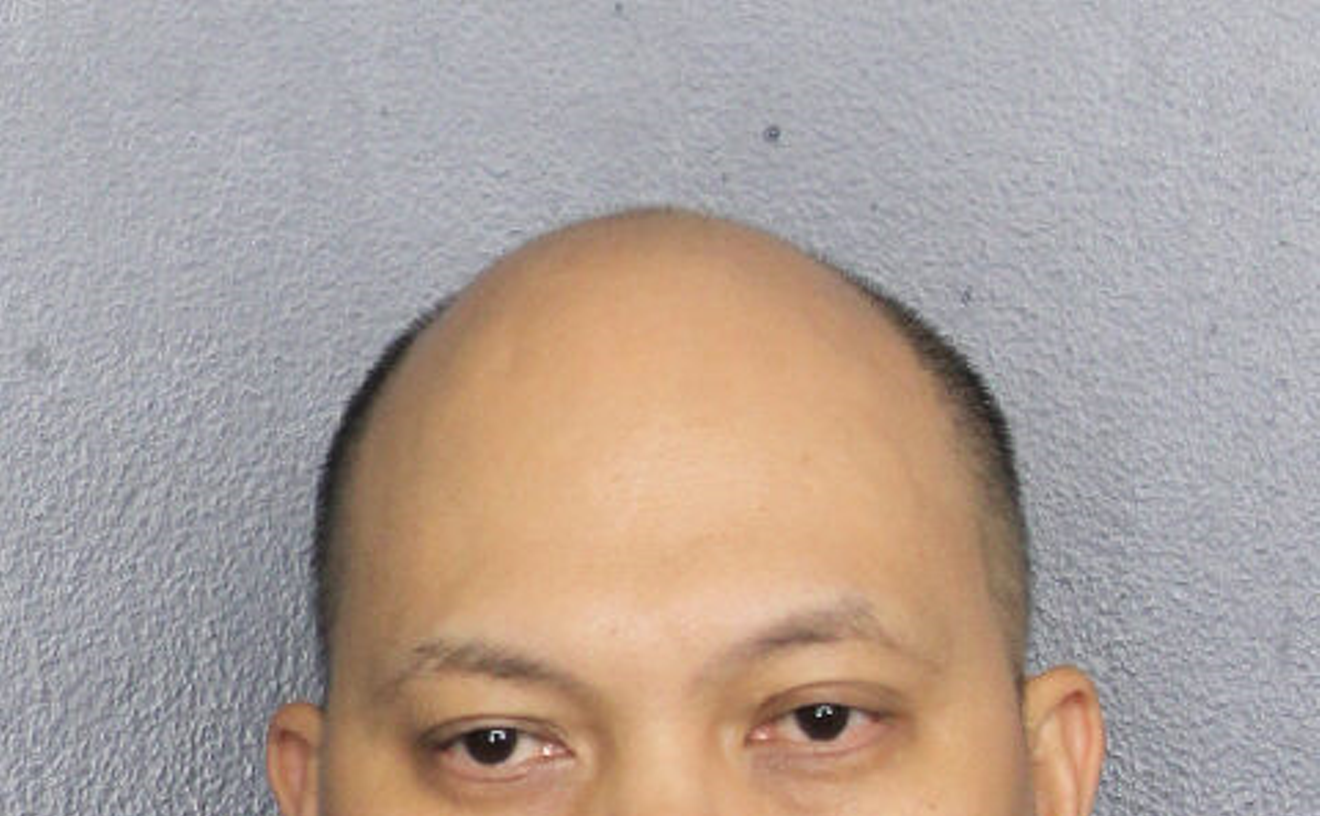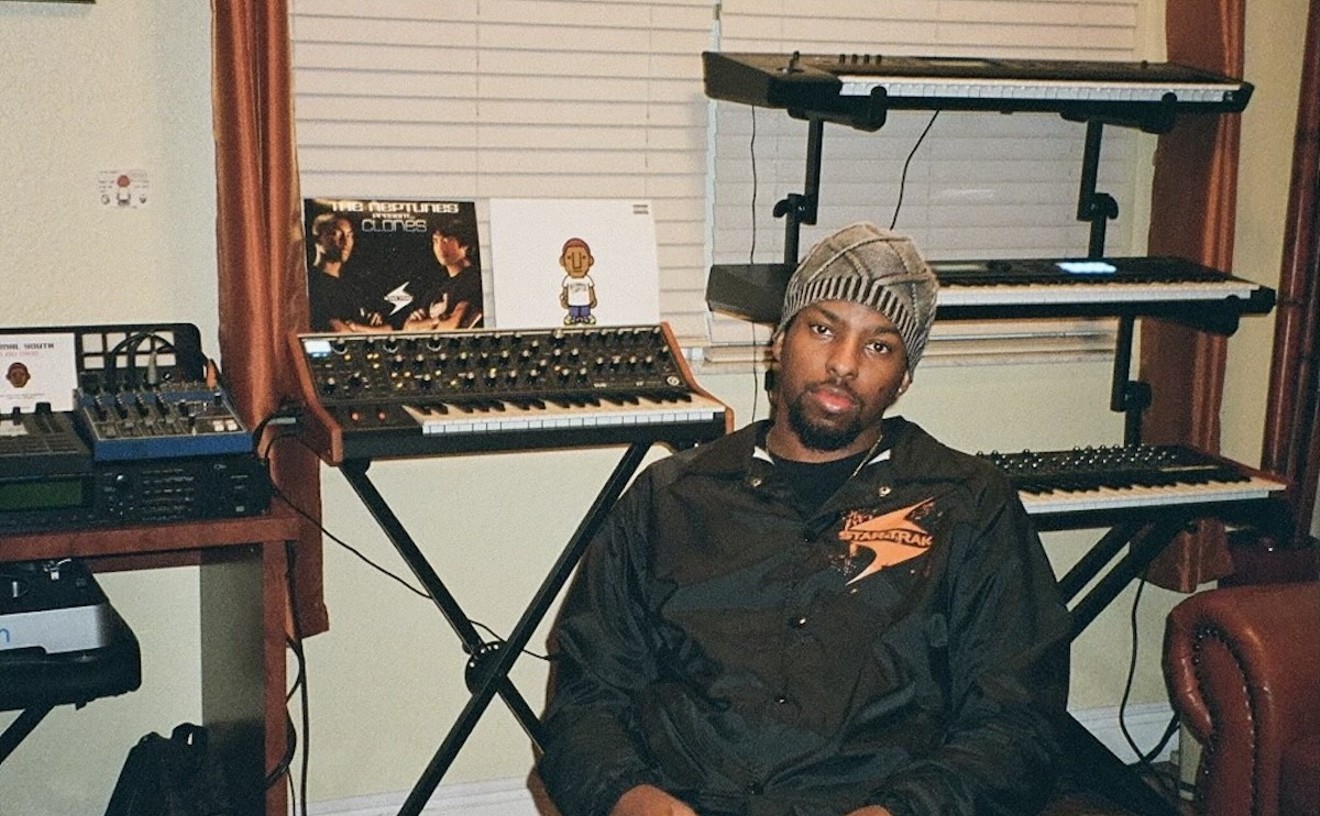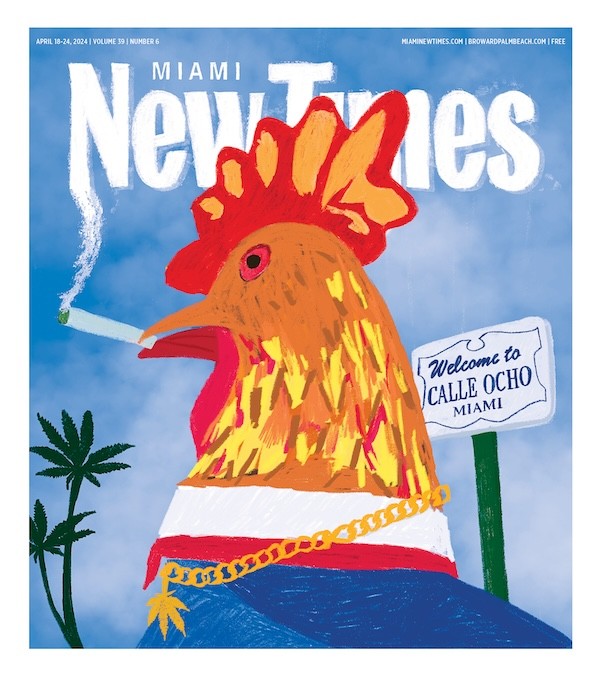"No," the doctor answers. Brown can't quite make out his face. "Take it easy. You can't walk."
"Why?"
"You can't get up. You lost your leg."
That can't be true. Brown can feel it there where it's supposed to be. He can feel his toes tingling. But he doesn't have enough strength to sit up and look for himself. He runs his hand limply down his body -- to prove to himself that both his legs are there. His hand moves slowly past his hip and onto his thigh. He's lost a lot of weight lying in this hospital bed, the once-bulky six-foot frame now down to 175 pounds. Slowly, he moves his hand across the leg.
A few inches down, his hand falls to the sheets. His fingertips run along the bandaged rough edge of what little of his right leg is left.
Brown wants to ask how and why, but sleep hits him again, perhaps for days. There are dreams of a car chase. Brown's hazy visions give him no answers about his leg. He wakes up again to hear his mother, Margaret Green, on the hospital room phone. "No, he didn't lose an eye," she's telling someone on the other line. "He ain't blind. He lost his leg." She pauses to hear a response. "People've been saying all kinds of things about him, like he lost both his arms."
Lying there, listening to the chug of the respirator keeping him alive, he tries to dig memories out of his cloudy mind. He sees images sometimes of that Saturday back in June of 2002, and the details start falling into place. He was making his twice-a-month trip from his home in Stuart to the flea market on 45th Street in West Palm Beach. He can remember that much for sure. Porsha Davis, his 18-year-old girlfriend, was there. And so was Jerome Maynor, an old friend. At 24 years old, Brown was working for a pressure-washing company and saving money by living with his parents. He fixed up old cars on the weekends and had $2,800 in his pocket from selling a couple of them. He had his eye on a Dixie Chopper lawn mower, one of those sit-on-top ones that a dealer in West Palm sells for a few thousand. A big mower like that might have gotten Brown started in the lawn care business, and he was supposed to take a look at a few models after the flea market trip.
Then he remembers the sirens of the police chasing them. Maynor, recently released from prison, is behind the wheel, Brown says. "I'm not going back," Maynor tells him urgently.
Brown wakes again to see another doctor in front of him. "What happened to them?" he asks. "You know, the people in my car."
There had been a drug deal, the doctor says. The police chased his car. And the whole thing ended in an explosion fit for a television cop show. "You," the doctor explains dryly, "were driving." As for his friends, "They didn't make it."
Stunned, Brown tries to process that. What about his leg? What happened to it? The doctor shrugs. Who knows? It may have been amputated at the hospital. Maybe it was lost at the scene of the crash.
It takes a month for the cops to get around to visiting Brown at St. Mary's Medical Center in West Palm Beach. Finally, Matt King, a traffic homicide investigator with the Palm Beach County Sheriff's Office, shows up. As King tells it, he walked into the hospital room and Brown immediately spit out that he "was just driving down the road." King turned on his tape recorder, but Brown said nothing more along those lines. Brown was still dazed. He could barely speak a coherent sentence through the painkillers, according to a transcript of the tape. Still, King read Brown his rights and asked him to read them back to him. "Yeah, I can read," Brown said, "but I can't, I can't say that I was the one driving." Brown asked for his attorney and King left, giving no more explanation about what happened or whether Brown would face charges.
For Brown, the hazy months in a hospital bed, the blurry sightings of the people around him, the fragments of memories of the events leading up to his hospitalization, the lost leg -- it had all begun to look like a 1940s noir movie, a black-and-white nightmare. As he slept, the dazed amputee in the hospital bed had somehow been transformed from an enterprising young man with a knack for getting old jalopies up and running into a police suspect. Incredibly for Brown, he had been targeted as the driver in a reckless car chase at three-digit speeds, the heedless destroyer of two other lives, a probable drug dealer.
It's still not clear what happened that day on the streets of West Palm Beach, not even to Brown, but both he and his lawyer scoff at the police scenario that will go before jurors sometime later this year. The weight of hard evidence shows that Brown, despite some significant trouble with the law in his teenaged years, was just an innocent passenger that day, says his attorney, Kristine Rosendahl of West Palm Beach. Unluckily for Brown, he has become the target of a squad of aggressive cops with a reputation for making high-profile arrests. Aggressive law enforcement can sometimes lead to misguided justice. It has become clear, Rosendahl says, that the state constructed a sloppy criminal case against Brown that rests entirely on fragile circumstantial evidence.
The crowning cinematic element to the plot is akin to a twist in a Hitchcock flick. Last May, Brown, who is slowly recovering at his sister's house in Stuart, gets a call from a relative. Brown is on TV. A special episode of America's Most Wanted titled "America Strikes Back" is rolling, and it features Brown as one of the country's most sought-after bad guys.
There it is on national television, a mug shot of Brown and the assertion by Palm Beach Sheriff's Office cops that he's considered dangerous, despite his physical condition.
Nearly a year after the accident, Brown figured the cops had decided against charging him with a crime. He left St. Mary's about two months after the accident and moved in with his parents in Jensen Beach. He goes back to the hospital twice a week for rehab, so he figured the cops would come knocking if they wanted him. Investigator King left his card on their front door one day. Brown says he called the investigator but didn't get a call back. That's all he has heard from the cops, he says.
By the time the show aired, Brown was starting to get used to his new prosthetic leg. It was too painful for him to walk with it fully, but he was starting to use crutches, and with pants on, no one could tell. He had even gotten together with an old girlfriend, Cathalina Green, an insurance agent in Stuart, and they had a baby on the way. You could say that Brown had begun to move on. The show changed that.
Brown watched the episode with the helpless, nightmarish feeling of watching an impostor play himself. The episode begins with footage of police officers, sheriff's office deputies, and Drug Enforcement Administration agents busting drug dealers in parking lots, wrestling them to the ground, handcuffing them on the hoods of cars, and then displaying bags of money for the camera. Correspondent John Turchin explains that a law enforcement "task force" had set up for just such an easy takedown on June 29, 2002. Officers that day were following a red BMW supposedly driven by a well-known drug kingpin. They tailed him to the parking lot of a Kentucky Fried Chicken, where he allegedly handed a brown paper bag out of the BMW's window and into Duane Brown's green Toyota Avalon. Cops assert on the show that Brown bought a quarter-kilo of cocaine from the BMW's driver.
Officers then radioed West Palm Beach police for help in stopping the Toyota, which had ducked onto northbound Interstate 95. The show splices shots of West Palm police and an African-American actor playing Brown with real-life footage from a radio car's on-board camera. Officer Regina Wood explains how it went down: "I got behind the vehicle, activated my blue lights. He pulls over to the slow lane like he's going to pull over, like a... a traffic stop. But all of a sudden, he basically gunned it." The camera in Wood's patrol car shows the Toyota pulling away on I-95, and the show cues guitar-heavy rock music. "I backed off because we have a no-chase policy," Wood explains. "We don't just chase vehicles that are just taking off from us."
Turchin explains what happened next: "Brown raced off the highway and onto a city street," where Wood lost sight of him as he hit speeds exceeding 100 mph. The road curves right on 45th Street, just before a Blockbuster; the driver of the Toyota made a tactical mistake there, trying to squeeze through a tight spot between a Dodge Intrepid and a Toyota Corolla. Instead, Brown's car sideswiped both cars. Careening out of control, his Toyota slammed into a concrete utility pole at an estimated 104 mph. Wood showed up seconds later. "It was horrific," she explains on the show.
The sheer force of the collision ejected Brown and Maynor. Brown landed just feet in front of the car, perhaps after bouncing off the pole. The jarring ejection tore his right leg into shreds. Maynor made out worse. He lost the bottom half of both legs and flew 20 feet forward. He landed on a concrete driveway.
The impact split the mast-like pole near its base, and the electric lines were straining to hold it from falling in the street. The Toyota caught fire on impact, incinerating Brown's girlfriend, Davis. The cruisers' video cameras show one brave cop trying unsuccessfully to douse the flames with an extinguisher. When the lines can't take any more of the pole's weight, several of them snap, landing on the flaming car. The wires and the flames combine into a massive explosion. Flames shoot up two stories, catching a mango tree on fire overhead. "Duane Brown would be the only survivor," Turchin concludes, "of the disaster cops say he caused."
Next, there's an interview with investigator King. "I never thought in a million years," King says, "that in Duane Brown's condition that he would be able to flee."
"But Matt got the shock of his career," the reporter breaks in, "when he called the hospital several weeks later to check on Duane Brown's condition. He learned his one-legged suspect was gone."
The show cuts to an interview with an expert in artificial limbs who explains how to spot the limp and sound the prosthetic leg makes when Brown walks. An amputee, maybe -- but, the correspondent warns, he's dangerous. "The ones that he killed," King says, "were his girlfriend and his best friend. And it could've been anybody."
On the Monday following the show, Brown turns himself in at the sheriff's office. America's Most Wanted runs a follow-up explaining that "Duane Brown is no longer limping from the law."
For Brown, it's as if his guilt is already decided. The show claims he's a fugitive from justice and a killer, and now he faces two counts of vehicular homicide.
"It was like it was happening to somebody else or something," Brown remembers of his first days in jail. "I mean, it was like a dream or something and I woke up as somebody else. I thought, 'This is it.' I mean, I didn't know if they were ever gonna let me out." It seemed over for him. At least until the state started building its case.
One question the show didn't address is whether there had been a high-speed pursuit. The West Palm Beach Police Department forbids such chases, unless a suspect is armed or otherwise poses a danger. Officer Wood notes in the television episode that she made the quick decision to break off the chase, as per department policy. But radio communications, recorded that day and available in court documents, tell a different story. Evidence of a chase may not prove Brown's innocence, but it could show that authorities bear part of the responsibility for the high speeds of the wrecked car, attorney Rosendahl says. "They should not have been chasing him that day, period," she says. "It shows, at the least, that these officers are unreliable."
After the three cop cars follow the Toyota onto 45th, West Palm Sgt. Daniel Henry asks for an update. "Did you try blue lighting already, and he's not stopping?"
"Ten-four," responds Wood, who had never been in a high-speed chase before. "He's not stopping. Just crossed Congress [Avenue]."
There's no indication from the encounter in the KFC parking lot that the Toyota's occupants are dangerous, but the task force clearly wants this bust. Among those who seem most interested is Brian Kapper, one of the department's most active antidrug agents. Early in the pursuit, Kapper tells the other officers that the Toyota's occupants are "possibly signal zero," the code for armed with a gun.
Henry, using a radio at police headquarters, isn't satisfied with Kapper's claim. With Wood's cruiser, Kapper's unmarked Taurus, and another patrol car tailing the Toyota on 45th, Henry asks them, "You got a supervisor with you?"
"Negative," Kapper responds. "I'm, uh... I'm trying to get with a, uh... another agency right now [to] reference this."
Henry still wants assurances. "All right. I need to know real quick, 'cause, uh... you know we have policy restrictions."
Henry's concern comes too late. One of the officers in pursuit, Lysa Bufford, radios that "he may have... signal four'd," the code for car crash. "Hit an electricity pole," Bufford explains as she arrives. "Car... had a rather explosion."
Many of the dozen or so witnesses to the crash can't say for sure whether they saw police in pursuit. Drivers of the Dodge and the Corolla that were sideswiped say it all happened too fast to know for sure. "We heard sirens," recalls Debbie Shields, a passenger in the Intrepid driven by her husband, Chuck. She says cops pulled up shortly after the crash, but the Shieldses aren't sure just how quickly. "I don't believe they were using excessive speed."
But another witness had a better view. Minutes before the crash, Marlene Alonso had left her job as cake decorator at Winn-Dixie. She had forgotten something at the supermarket, and she was about to make a U-turn on 45th and North Shore Drive. That's when Brown's Toyota came racing toward her, with cops directly behind it, she says. "I mean, they were right behind them," Alonso says. "They were in full pursuit." Newspaper articles after the accident claimed cops broke off the chase, but Alonso says otherwise. "It was unit after unit. They had their sirens and lights on. The whole bit."
West Palm officers adamantly insist there was no high-speed pursuit. An internal affairs investigation cleared them of any wrongdoing, despite the incorrect claims of a gun in the car (none was ever found) and evidence that there was a chase. The sheriff's office took over the criminal investigation. Sgt. John Churchill, who was in charge of the inquiry, agrees with West Palm police that there was no chase. Alonso may be lying, he says. "People say lots of things," Churchill says. "Who knows if they are just trying to get attention in the media? Then they get on the witness stand and say something completely different."
Wood, with the department just three years, got a promotion after the chase. Supervisors moved the former kickboxing instructor and Rhode Island corrections officer to special investigations, where she now works with Agent Kapper.
At least one of the officers involved, however, quit in part because of the incident. Bufford, a cop for only a few months when the chase happened, resigned less than a month later. "It was part of the reason," Bufford says from her West Palm Beach home, but she declined to elaborate further. In her July 22, 2002, resignation letter to the department, Bufford claims "rumors and disrespectful comments" led to her decision to leave. "I feel that I am no longer able or capable to be a part of this police department."
The evidence against Brown seemed to be diminishing before the investigators' eyes.
Cops searching the Toyota failed to find a gun, a brown paper bag, or any sign of the "quarter-kilo of drugs." They chalked it up to the fire, though documents in the court file carefully describe an array of items in the Toyota, right down to the color of Davis' underwear and the yellow lighter in Maynor's pocket.
Officers who claim to have witnessed the drug bust can't say who was driving the Toyota, according to court records. The car's tint prevented them from seeing inside. Absent from the investigation, apparently, was the high-tech surveillance equipment often used in drug busts. In statements he made for the case, Kapper has said they didn't expect to do more than pull over the Toyota and make a simple arrest.
Kapper and the DEA agents have teamed up before to convict drug dealers by using tactics that have been attacked by defense lawyers. In August, Kapper and the DEA agents oversaw the conviction of Elroy "Eighty-Six" Phillips, whom they claimed to be one of West Palm's biggest drug kingpins (see "86ed" in New Times, September 18, 2003). In that case, lost police reports and the testimony of felons receiving remuneration helped to convict Phillips.
In strikingly similar circumstances, Phillips was convicted after Kapper claimed to have witnessed a drug deal that the task force failed to catch on audiotape or videotape. Phillips is now serving 30 years in federal prison. Phillips' attorney, Randee Golder, says Kapper and his DEA colleagues are well-known for their aggressive tactics. "Certainly," she says, "there's a history of these guys jumping out of vans in ninja outfits and pinning a whole group of people against the wall. I can't say that they're overly aggressive, but their names do come up a lot in these kind of cases."
The fact that Brown ended up on America's Most Wanted may indicate problems in the case, Rosendahl says. Brown's parents and others have testified that he was living at home during the time police say he was on the lam, and his doctors affirm that he came several times a week for checkups at the West Palm hospital. Churchill says deputies went to the Jensen Beach home of Brown's parents but never made contact with anybody. The sergeant says they were hampered by the fact that they don't have the right to arrest someone in Martin County, relying instead on local law enforcement to tag along. "We did a lot to look for him," Churchill says. "That, I can assure you."
At a recent court hearing, Brown's mother, Margaret Green, disagreed. "My baby, he was with us the whole time," Green said, after angling her son's wheelchair out of the courtroom doors. "Then they put him on TV and said he was a criminal. It's not right what they did to him. It's not right." Even the family of Porsha Davis has backed Brown's attempts to clear his name, testifying in court about his good character and asking the state to drop the charges.
Perhaps most damning to the state's case, however, is the DNA evidence investigators collected from inside the Toyota. Investigators hoped some of the blood found on the driver's side of the car would lead to Brown, a clear-cut sign that he was driving. In November of last year, the sheriff's office crime lab issued its analysis of the blood samples, finding that the blood on the driver's-side door belonged to Jerome Maynor. In the report, Senior Forensic Scientist Tara L. Sessa determined: "Duane Brown... is excluded as a contributor to this DNA profile."
Judging by his record, Jerome "High Class" Maynor may have had more to do with the fatal chase than cops first claimed. Brown knew that his friend, whom he met ten years ago when Maynor was dating his sister, had just gotten out of jail. But he didn't know the details of what Maynor had done to get there. In fact, his conviction had also had to do with a crime committed behind a steering wheel.
On February 15, 1997, Stuart Police Officer John Miedzianowski pulled Maynor over for driving erratically. Maynor had a cooler with open liquor bottles in the back seat, Martin County court records show, and Miedzianowski ordered him to get out of the car. Maynor refused, and the cop reached inside to pull him out. Maynor then shut his window on the cop's arm. As Miedzianowski struggled to free himself, Maynor slammed the car in reverse, crashing into the police cruiser behind him. Miedzianowski finally broke free by smashing the window with his left hand, and Maynor sped off, weaving recklessly through traffic on U.S. 1 in Stuart. He sideswiped two cars before finally stopping for cops about five miles after the chase began. A judge sentenced Maynor to 36 months in prison for aggravated fleeing, leaving the scene of a crash, and aggravated battery on a law enforcement officer. Maynor got out of prison June 28, 2002, the day before the fiery crash that claimed his life.
Before they left Brown's home in Jensen Beach, Brown says, he asked Maynor to drive his car because he had burned his left leg on the exhaust pipe of a friend's dirt bike. There are witnesses who can vouch for the nasty, open sore on his leg before the accident, Brown says, and his mother readily backs him up. "He wasn't driving no car," she says. "I know he wasn't because he couldn't. Not with that burn on his leg that day, he couldn't."
Brown claims that when he heard the details of what put Maynor behind bars, it made sense of the image he had in the hospital. "He was driving my car. He kept saying, 'I'm not going back. '"
Brown himself doesn't have a clean past. A judge sentenced him to 60 days in jail in 1999 for felony possession of coke. Before that, he served a month for carrying a concealed firearm, and he spent more than a year at the Hendry Work Camp prison in 1996 for burglary and possession of burglary tools, according to state records. But Brown insists he's been living a quiet, law-abiding life for the past five years.
Rosendahl speculates that Brown's past is the reason the cops wanted him so badly. Questions about the alleged drug bust, the DNA evidence, and the other problems with the police investigation should be enough to convince a jury of Brown's innocence, she contends. Says Rosendahl: "You've got enough questions out there to really make anyone doubt this one. No one can say for sure that Duane Brown was driving, and all the hard evidence points to the fact that he wasn't."
Still, investigators and prosecutors stand by their claim that Brown was driving. Assistant State Attorney Ellen Roberts, an expert in traffic homicide cases, says the most damning evidence against Brown is the remains of Maynor's right foot. Investigators found it with the shoe still attached under the passenger seat. "The only problem [with Brown's defense] is that the other fella left his leg in the back seat," Roberts says.
However, prosecutors routinely use an opposing argument in similar cases. Crash investigators say body parts often fly around haphazardly in a high-speed collision. And the explosion that followed the impact also could have scrambled the evidence. Seeming to prove that point, investigators found Maynor's left leg in an odd spot. As a tow truck driver pulled the Toyota away, Maynor's leg fell from between the car and the concrete pole. How it got there is a mystery.
An equally important mystery to Brown, however, is what happened to his leg. No one is sure.
Roberts, the prosecutor, says she heard it was amputated at the hospital. "This much we know," she says recently in a courtroom hallway after a hearing on Brown's criminal case. "It was just sort of hanging off, and they took it off the rest of the way." But Roberts admits that she isn't sure of this. She hasn't seen Brown's medical records, and cops at the scene were inconclusive about what happened to the leg.
Churchill thinks Brown's limb may have been thrown out. "I can give you some speculation on it," the sergeant says. "The thing could still be in the car. It may have been discarded as medical waste. If it's unusable, they're not going to keep it around." The crumpled Toyota will sit in the sheriff's office impound lot until Brown's case is resolved. It doesn't look much like a car anymore, instead just a collection of unidentifiable engine parts and charred paint. "Realistically speaking," Churchill clarifies, "the leg is not in the car."
The fact that his leg hasn't been found troubles Brown, though he says he doesn't dwell on it. At his attorney's office recently, Brown wants to talk about what's next for him. He says he wants to go back to work sometime next year for the pressure-washing company. He wants to start fixing cars again. He hasn't gotten used to his prosthetic leg yet. It's still too painful for him to walk on it without crutches. "I'm getting better with it," he says positively.
Cathalina had their baby on July 13. It's a boy they named Dakari. He's got a head cold now, Brown says, as Cathalina wipes the squirming toddler's nose. "He's a good baby, though," Brown says. "He sleeps through almost every night."
With the baby and his future to think about, it's hard for Brown to think back to the day of the accident and those fragmented images that swirled through his mind in the hospital. When his case goes to trial, he'll have to convince a jury that those hazy memories are a true reflection of what happened.










